An automatic test method for wax appearance temperature of VLSFO's
Article by Dr. Malcolm Cooper & Dr. Joshua Sun
Summary
Wax Appearance Temperature (WAT) or cloud point, hereinafter referred to as WAT, is the temperature at which wax crystals appear when fuel is cooled. This ultimately results in was perception causing the fuel to stop flowing, which had a detrimental; impact on operability as it may block filters and pipes, causing fuel starvation and engine problems. Proving that the fuel temperature does not fall below the WAT it will not wax, so measuring this temperature is critical in managing risk.
The measurement of the WAT of Very Low Sulphur Fuel Oils (VLSFO'S) is problematic because although various manual and instrumental methods are available, the opacity of the fuel produces unacceptable wide errors. Whilst pour point may be used as a useful cold-flow property, the definitive indicator used to identify wax precipitation is the WAT.
VPS has developed an in-house method for the measurement of WAT for VLSFO’s. The technique is based on ASTM D5773 and involves direct detection of light scattered by wax crystals using the same technology that has been used to measure the WAT of crude oil for some years. Significant work has been carried out to modify the equipment instrumentation and optimise experimental conditions for VLSFO fuel types. It is sensitive, precise and reasonably quick in delivering results. The method has been validated by correlating results of a series of distillate samples with an existing method and repeatability has been assessed on several VLSFO samples across a wide temperature range (10˚ C to 65˚ C). The WAT of many VLSFO samples bunkered over the past months has been measured and graphed. The wide variation of these results indicates the importance of measuring this parameter to mitigate cold-flow operability problems for VLSFO’S.
VLSFO Cold-Flow Problems
Compliance with the 2020 IMO 0.5% sulphur cap has driven the introduction of new 0.5% VLSFO’s produced by blending low sulphur distillates with conventional Heavy Fuel Oil (HFO). The chemical composition of these new VLSFO blended fuels is variable but strikingly different to HFO, as shown in the table of typical compositions shown below.

The increased paraffinic content (saturates) arising from the distillate composition of the new blended 0.5% VLSFO increases the likelihood of wax precipitation compared to HFO fuels. The temperature at which wax precipitation starts is dependent upon the chemical composition which varies significantly from fuel to fuel. Measurement of the temperature at which wax precipitation starts (the WAT, which is the temperature at which wax crystals appear) is important to determine the cold-flow risk of VLSFO fuels.
Current Methods for Measurement of Cold-flow Properties
There are 3 test methods used to evaluate the cold-flow properties and likelihood of formation of wax crystals in fuel. For distillates all 3 methods can be applied as they are clear fuels, but for HFO and VLSFO’s only pour point has been applied due to the high opacity of these fuels.
Cloud Point (CP) – The temperature at which wax crystals start to form in the fuel, detected by visually seeing the fuel shift from being transparent to cloudy (ISO3015) or using instrumentation (ASTM D5773 using a light source in the visible wavelength).
Pour Point (PP) – The lowest temperature at which the fuel will continue to flow when cooled, detected visually (ISO3016) or using instrumentation (ASTM D5949, ASTM D6749-02).
Cold-filter Plugging Point (CFPP) – The lowest temperature at which a fuel of known volume continues to flow within a specified time (60 seconds) when drawn by vacuum through a standardized filter (45 micron) (ASTM D6371).
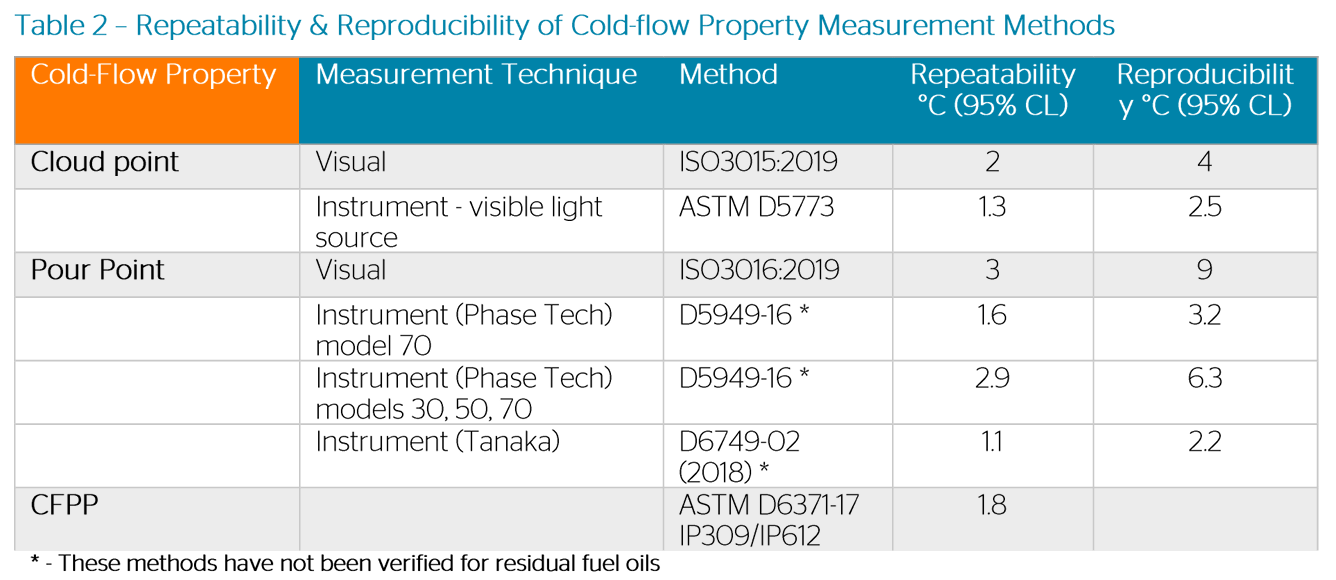
Cloud point is the definitive cold-flow property measure, since this indicates the temperature at which wax crystals start to form. The fuel will continue to flow at temperatures above the cloud point. Current test methods do not enable cloud point to be measured for opaque fuels as stated below:
ISO3015 (visual method) states that ‘it may only be used for the determination of the cloud point of petroleum products which are transparent in layers 40 mm in thickness’
ASTM D5773 (using a light source in the visible wavelength) states in the scope that ‘This test method covers the determination of the cloud point of petroleum products and biodiesel fuels that are transparent in layers 40 mm in thickness by an automatics instrument using a constant rate’
Pour point identifies the temperature at which the marine fuel ceases to flow making the fuel unusable. This is currently the only method of measuring the cold-flow properties of opaque fuels (such as HFO, as indicated in ISO8217). The visual method (ISO3016) has very poor repeatability and reproducibility whilst the automated methods (ASTM D5949-16, ASTM D6749-02) have not been verified for residual fuel oils.
A fundamental problem with the measurement of pour point to assess the risk of fuel waxing is that once the pour point is reached, the fuel has stopped flowing and started to solidify already creating problems. For this reason, the recommendation by CIMAC is to keep the fuel at 10˚ C above the pour point. However, since the definitive cold-flow property measure is cloud point (the temperature at which wax crystals form) it is useful to understand the correlations between pour point and cloud point.
Many distillate samples have been measured for both cloud point and pour point over the past few years by VPS. A graphical representation of the correlation between cloud point and pour point on distillate samples has been produced below. This data (>15,000 data points) shows a poor correlation with a measure of R2=0.358, as indicated in the graph below. This demonstrates that pour point is a poor indicator of the cloud point (i.e. wax formation temperature) of fuel. This is perhaps unsurprising since pour point is affected by additives in the fuel, whereas cloud point is not as this is a fundamental fuel property.
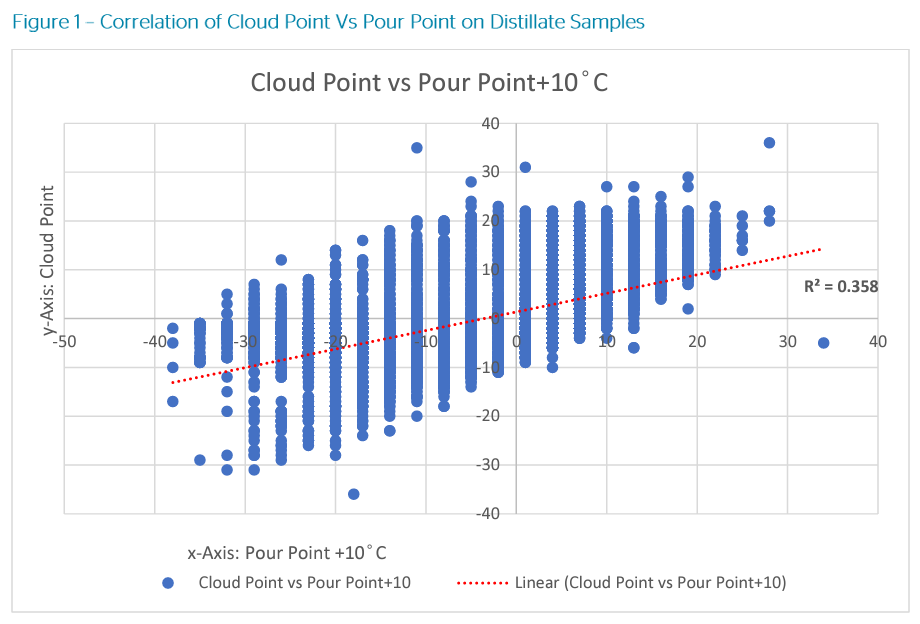
The cold-flow properties of HFO are based on pour point because there are currently no methods available to measure cloud point due to opacity, and CIMAC guidance is to maintain a temperature at pour point +10˚ C to prevent problems. However, there is no correlation between pour point and cloud point as indicated in Figure 1 above. This illustrates the need for an accurate method for the measurement of cloud point in opaque fuels.
VPS Method (VPS-LP1307) for Measurement of WAT/Cloud Point of VLSFO’s
VPS has developed an in-house method for the measurement of WAT of VLSFO’s based on ASTM D5773 with instrumentation using non-visible light. Significant work has been carried out to modify the equipment instrumentation and optimise experimental conditions for VLSFO fuel types.
However, the underlying principles of this method have been applied in the measurement of wax crystal formation (WAT) in opaque crude oils in the Upstream sector for some years. This technology works on opaque oils because the light source is outside the visible spectrum. This method is used to help companies engaged in crude oil production, storage and transportation to define acceptable operational limits to prevent wax crystals forming which may restrict flow or create blockage.
The operating principle of the instrument is an optical light scattering technique which detects phase changes of crude oil with high levels of sensitivity and accuracy. The presence of wax crystals is detected in the fuel by measuring the scattering of a light source as in the diagram below. Since it is an instrumental technique the measurement is not subjective. The phase change detected is the temperature at which a crude oil sample first precipitates solid wax as it is being cooled, which is termed WAT. Similarly, the Wax Disappearance Temper (WDT) is the temperature at which the last wax solids are melted into liquid when the oil is warmed.
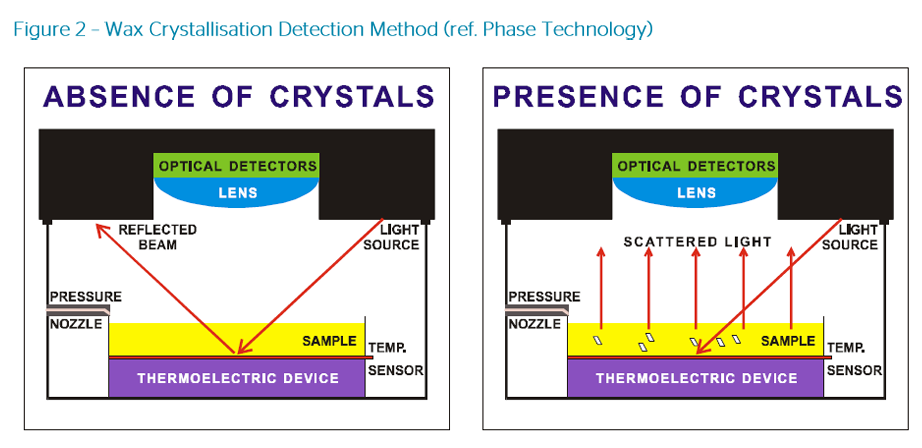
VPS has developed an improved method of measuring the formation of wax crystals in VLSFO’s (VPS method LP1307). Significant, work has been carried out to modify the equipment instrumentation and optimise experimental conditions for VLSFO fuel types. The method is sensitive, precise and reasonably quick in delivering results.
Validation of VPS Method (VPS-LP1307) for Measurement of WAT of VLSFO’s
Several clear distillate blends have been tested using the new VPS method (VPS-LP1307) with instrumentation using non-visible light. These results were compared to the standard method using instrumentation with visible light. Very good correlation between the results was obtained with a measure of R2=0.98, as indicated in the graph below.
In addition to the WAT, the method provides a measurement of the WDT. This is vey useful as it is the temperature at which the last wax solids are melted into liquid when the oil is warmed. As such it provides an indication of the temperature that the fuel must be heated to in order to fully dissolve any wax solids that have precipitated.
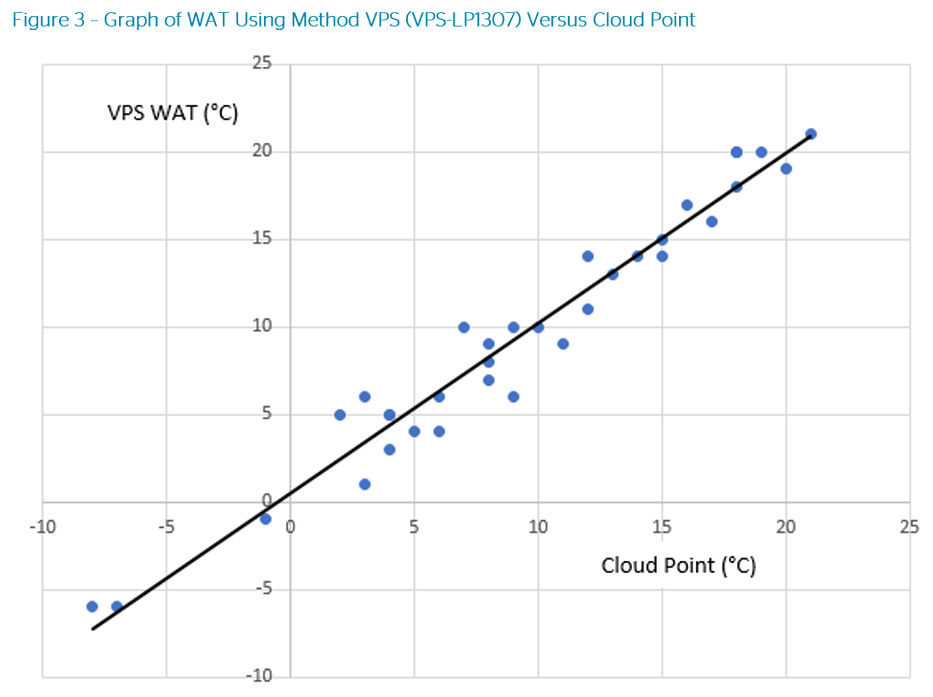
Repeatability of VPS Method (VPS-LP1307) for Measurement of WAT/Cloud Point of VLSFO’s
Four different fuels that had been bunkered in the ports of Singapore, Rotterdam and Houston were tested multiple times (x12) using the newly developed VPS Method (VPS-LP1307). These four different fuels each had very different WAT across the temperature range of 10˚ C to 65˚ C. The table below summarises the repeatability of these results, which shows that this method is very repeatable across the full range of temperatures.

Results of WAT and WDT Measurement of VLSFO Samples Using VPS Method (VPS-LP1307)
A number of VLSFO samples (87 in total) bunkered over the past few months across ports in Singapore, Rotterdam Houston and Fujairah have been tested using the new method. The graph below shows the spread of results. The WAT point results show a very wide range for VLSFO fuels already on the market and a number of these are elevated temperatures. This demonstrates the importance of measuring WAT for the VLSFO fuels. The WDT results indicate the temperature that these fuels would need to be heated to in order to melt all wax solids if the fuel temperature has fallen below the WAT causing waxing.
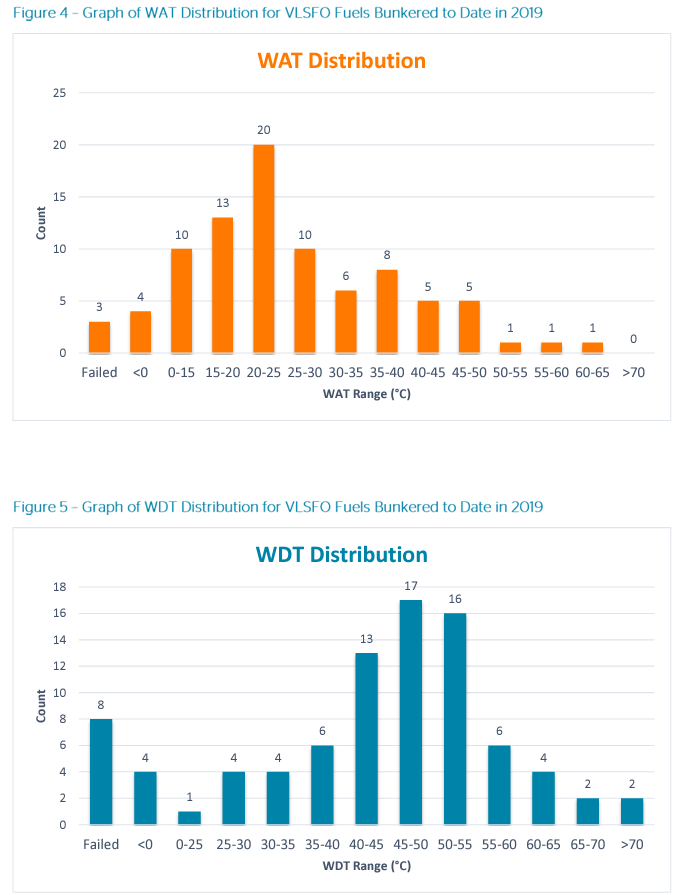
Summary
VPS has carried out extensive research and development this new method. VPS-LP1307 for identifying the WAT on VLSFO opaque fuels. The method is sensitive, precise and has a reasonably quick analysis turnaround time. The measurement of WAT is critical in mitigating the risk of cold-flow problems when handling VLSFO fuels. Additionally, this method enables the measurement of WDT.
 Search
Search
 Customer
Customer